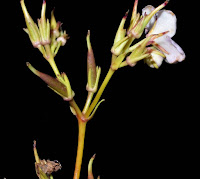 |
| Paraboea khaoyaica Kaitongsuk, Triboun & Sungkaew in Kaitongsuk, Triboun, Suddee, Ue-Aree & Sungkaew, 2021. ชาฤๅษีเขาใหญ่ || DOI: 10.26492/gbs73(1).2021-09 |
ABSTRACT
Paraboea khaoyaica Kaitongsuk, Triboun & Sungkaew, a new species from Southeastern Thailand, is described and illustrated and its conservation status is assessed. The species is currently only known from the type locality.
Keywords. Asia, endangered, Khao Yai National Park
 |
| Paraboea khaoyaica Kaitongsuk, Triboun & Sungkaew. A. Habit. B. Open flower and young fruits. Drawn by Orathai Kerdkaew. |
Paraboea khaoyaica Kaitongsuk, Triboun & Sungkaew, sp. nov.
Paraboea khaoyaica is similar to Paraboea pubicorolla Z.R.Xu & B.L.Burtt in having 1–3 subterminal inflorescences, leaves that are elliptic or ovate and with narrow wings at the base of the petiole joining across the nodes, and, unusually for species in the genus, occurs in a similar sandstone habitat. It differs in having a glabrous and flatfaced campanulate corolla with tube 4–5 mm long (vs a glandular hairy and deeply campanulate corolla with tube c. 7 mm long in Paraboea pubicorolla), filaments 1.5–2 mm long and glabrous (vs c. 4 mm long and pubescent in P. pubicorolla), and capsules 1–1.5 cm long (vs 2.5–3 cm long in P. pubicorolla). Paraboea khaoyaica is also similar to P. chumphonensis Triboun in the similar size of leaves and its flatfaced campanulate corolla with tube c. 4 mm long. It differs, however, in having a glabrous ovary (vs pubescent ovary in Paraboea chumphonensis), slightly shorter and glabrous capsules 1–1.5 cm long (vs slightly longer capsules c. 1.8 cm long which are covered with glandular hairs in P. chumphonensis), and occurrence in a sandstone habitat (vs limestone habitat in P. chumphonensis).
Distribution. Endemic to Southeastern Thailand.
Ecology. Growing on sandstone rocks along a stream and on moist rocks in partial shade in bamboo and dry dipterocarp forest, alt. 100–150 m.
Etymology. The specific epithet refers to Khao Yai National Park (the type locality).
Vernacular name. Cha Rue Si Khao Yai (ชาฤๅษีเขาใหญ่).
Saksan Kaitongsuk, Pramote Triboun, Somran Suddee, Phasit Ue-Aree and Sarawut Sungkaew. 2021. Paraboea khaoyaica (Gesneriaceae), A New Species from Thailand. Gardens’ Bulletin Singapore. 73(1); 203–207. DOI: 10.26492/gbs73(1).2021-09







